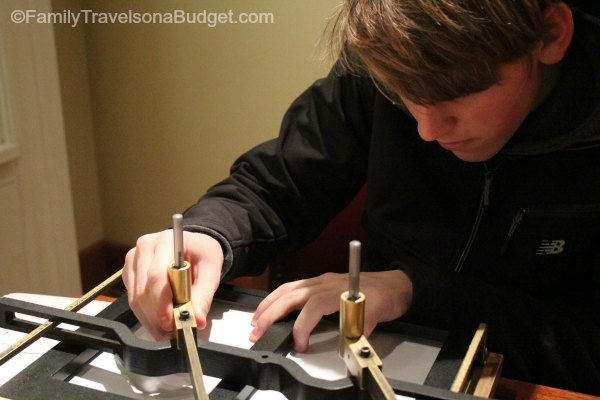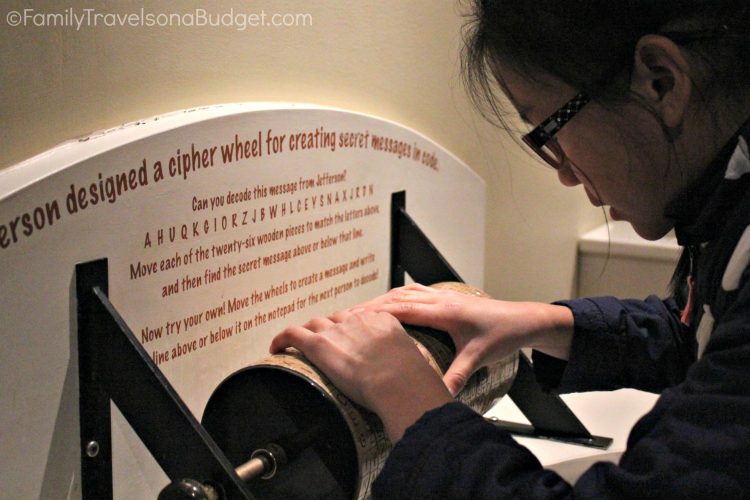Thomas Jefferson’s Monticello
This post may contain affiliate links. Click here to see what that means.
I’ve gotten to visit Monticello twice in the past year. The first visit gave me a strong sense of Thomas Jefferson: his values, his sense of place in this world and his incredible intellect. My second visit, armed with Jeffersonian knowledge, I felt a freedom to learn more about plantation life in the late 1700s, the impact of slavery — for slave and for slave-owner, and Jefferson’s worldwide impact.
Simply put, the man was a genius! Monticello, his beloved home, is designed to be warm in the winter and cool in the summer — and that’s without electricity! He added conveniences to make entertaining easier, for himself, his guests and his servants. He designed the home so logically, and yet so elegantly. The house alone is worth a visit.
The Thomas Jefferson Foundation, which maintains the property, has done an incredible job making Jefferson’s life and accomplishments something that visitors of any age can appreciate.
The Monticello Day Pass
The main attraction at Monticello is the guided tour of the house’s first floor, which guests get to by bus. Museum guides tell stories from Jefferson’s time in the home, explain artifacts, inventions and architectural elements as they take guests through the house. After the guided tour, visitors can explore the cellar and grounds. Displays explain each area, including the cellar, kitchen, smokehouse and some slave quarters. Outside the house, explore the vegetable garden and take in the views across the mountain.
Once you’ve had your fill, take the bus back to the Thomas Jefferson Visitor Center and visit the museum which highlights more of Jefferson’s technology, ground-breaking research and political influence. Located on the lower level of the Smith Education Center, the Griffin Discovery Room (a highlight on our second trip) provides a hands-on museum area for kids. Big kids are welcome to enjoy it too! Try writing like Jefferson did with his polygraph machine (it’s really hard!). Try on 18th century clothes, play games, explore slave quarters, or sit in Jefferson’s chair. We had to tempt our 17 year old away with a promise of food!
Monticello for Kids
Monticello’s historians have done a fabulous job making a Monticello visit enjoyable for kids.
- The Griffin Discovery Room is a great place to start. Let kids learn about Monticello here, then have them look for these same artifacts on the house tour. (Or take the house tour, and then let them explore the Discovery Center)
- Exploring Monticello. This downloadable PDF booklet introduces kids to Monticello through the eyes of Cornelia Randolph, Jefferson’s granddaughter. Among other things, it tells kids how Monticello was lit at night (by whale oil) and how long it took to build (40 years). Cornelia also explains Jefferson’s “gadgets and gizmos,” daily life at Monticello, the gardens and the role of slaves on the estate. It’s a great resource!
- A Day in the Life of Thomas Jefferson. So, maybe this is good for big kids, too. I certainly found it interesting! Click the link to go through a typical Jefferson day at Monticello.
Travel Tip: Before visiting Monticello, download Exploring Monticello so kids can read it and learn about Jefferson. It will give them an “anchor” to remember what they see and hear on the house tour. (And they’ll look like little geniuses because they’ll know some of the answers to the guide’s questions!)
Mom Says Kids Say
Mom:
My first visit to Monticello was cold and rainy — that’s not the best weather as there’s so much to see outdoors. Dress for the weather if you go on a cold, rainy day. On both visits, I saw weary parents dragging little kids through the house and grounds. The house tour is about 30 minutes long, and most groups are about 20 people. Consider whether your little one is ready for that. Take time to explore downstairs (the kitchens and slave areas), the gardens and the Rubenstein Visitor Center (aka, museum). There’s so much more to Monticello than “just” the house tour. Don’t miss out!
Kids:
Ellie (10): My favorite part of Monticello is the kids museum. You can try to build it with blocks, but that’s really hard. So is writing with the copier pen (the polygraph). I thought it would be easy but it’s really not. I liked decorating the fireplace, figuring out the secret decoder message and dressing up like people did a long time ago. The kids museum is the best part of this place.
Ben (17): Thomas Jefferson is so important to the history of America that everyone should come visit (Monticello). My favorite thing is the clock in the front entrance of the house. I liked the dumbwaiter in the chimney, too. Under the house is a huge, round ice room and the kitchen and storage areas. It’s a lot different than most house kitchens now. The story of what happened to his freed slave (James Hemings) is really hard to learn though.
Jefferson’s famous clock (the outside part) and my silly children!
Visiting Monticello
Ticket prices and hours vary depending on the tour you choose. I strongly recommend purchasing tickets in advance if you want to visit on a particular day and/or time.
- Click here for ticket prices and availability.
- Monticello is open every day except Christmas day. Click here for hours.
Save with these special offers.
- The Monticello Neighborhood Pass which includes admission to Monticello, Ash Lawn-Highland and Michie Tavern.
- Home Educators’ Day, which offers discounts to homeschooling families. (This year, Home Educators’ Day is Wednesday, Sept. 23, 2015)
- A hotel package that includes tickets to Monticello.
We’d love your advice on Monticello. Do you have any tips for first-time visitors? What did you enjoy most about it?





